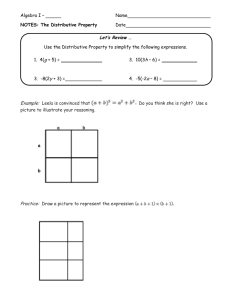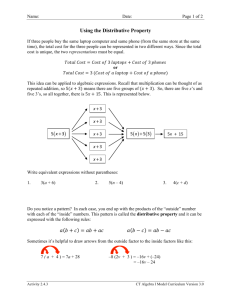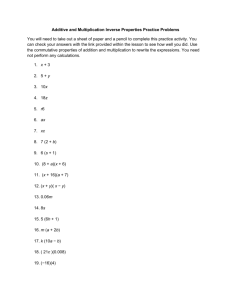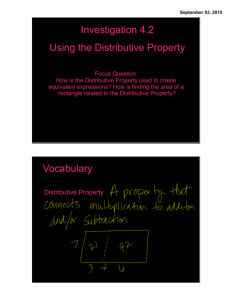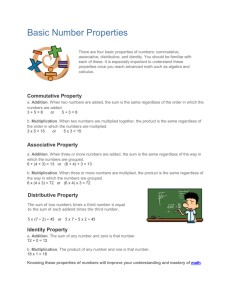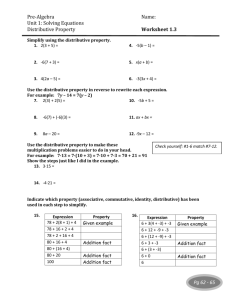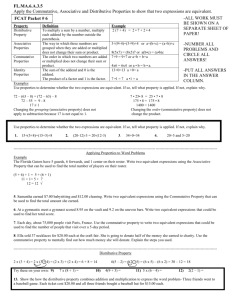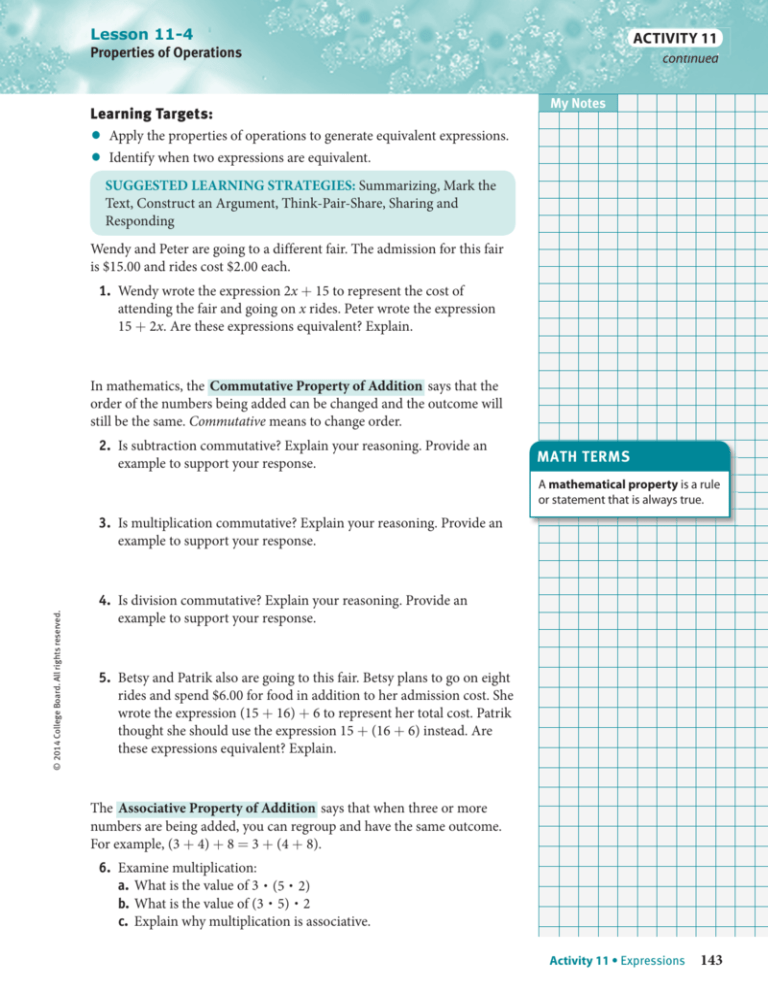
Lesson 11-4
Properties of Operations
ACTIVITY 11
continued
Learning Targets:
Apply the properties of operations to generate equivalent expressions.
Identify when two expressions are equivalent.
My Notes
•
•
SUGGESTED LEARNING STRATEGIES: Summarizing, Mark the
Text, Construct an Argument, Think-Pair-Share, Sharing and
Responding
Wendy and Peter are going to a different fair. The admission for this fair
is $15.00 and rides cost $2.00 each.
1. Wendy wrote the expression 2x + 15 to represent the cost of
attending the fair and going on x rides. Peter wrote the expression
15 + 2x. Are these expressions equivalent? Explain.
In mathematics, the Commutative Property of Addition says that the
order of the numbers being added can be changed and the outcome will
still be the same. Commutative means to change order.
2. Is subtraction commutative? Explain your reasoning. Provide an
example to support your response.
MATH TERMS
A mathematical property is a rule
or statement that is always true.
© 2014 College Board. All rights reserved.
3. Is multiplication commutative? Explain your reasoning. Provide an
example to support your response.
4. Is division commutative? Explain your reasoning. Provide an
example to support your response.
5. Betsy and Patrik also are going to this fair. Betsy plans to go on eight
rides and spend $6.00 for food in addition to her admission cost. She
wrote the expression (15 + 16) + 6 to represent her total cost. Patrik
thought she should use the expression 15 + (16 + 6) instead. Are
these expressions equivalent? Explain.
The Associative Property of Addition says that when three or more
numbers are being added, you can regroup and have the same outcome.
For example, (3 + 4) + 8 = 3 + (4 + 8).
6. Examine multiplication:
a. What is the value of 3 (5 2)
b. What is the value of (3 5) 2
c. Explain why multiplication is associative.
⋅ ⋅
⋅ ⋅
Activity 11 • Expressions
143
Lesson 11-4
Properties of Operations
ACTIVITY 11
continued
My Notes
7. Are subtraction and division associative? Explain your reasoning.
Provide examples to support your response.
8. Describe the similarities and differences between the Commutative
and Associative Properties.
9. a. Apply the Commutative Property of Multiplication to create an
expression equivalent to 5(6).
MATH TIP
Multiplication can be represented
using several different symbols.
b. Apply the Associative Property of Addition to create an expression
equivalent to (5 + 9) + x.
⋅
For example, the expressions 3 5
and 3 × 5 both mean “3 times 5.”
Likewise, “4 times a” can be written
4 a, 4 × a, or just 4a.
⋅
10. Identify the property illustrated in each equation.
a. (2 8) 9 = 2 (8 9)
⋅ ⋅
Usually in algebra the symbol × is
not used for multiplication,
because it could be easily
confused with the variable x.
⋅ ⋅
b. 3.6 + 5.7 = 5.7 + 3.6
(
) (
)
(
)
c. 1 + 1 + 1 + 1 = 1 + 1 + 1 + 1
3 5
7
3
5 7
The Additive Identity is the number that can be added to any number
without changing its value.
11. a. What number will make 3 +
= 3 a true sentence?
The Multiplicative Identity is the number that can be multiplied by
any number without changing its value.
12. a. What number will make 3
⋅
= 3 a true sentence?
b. What number is the Multiplicative Identity?
13. Make sense of problems. Drew and Seth were in charge of
collecting the money for their class field trip to the fair. They
collected the estimated cost of $36.00 from each of the 16 girls and
14 boys in their class. Then they found out that the fair would give
them the special price of $32.00 per person. To determine the total
amount of money due back to the class, Drew wrote the expression
(16 + 14) 4. Seth wrote the expression 16 4 + 14 4. Explain
why both boys are correct.
⋅
144
Unit 3 • Expressions and Equations
⋅
⋅
© 2014 College Board. All rights reserved.
b. What number is the Additive Identity?
Lesson 11-4
Properties of Operations
ACTIVITY 11
continued
The expressions written by the boys illustrate the Distributive Property.
In Seth’s expression, the 4 has been distributed to both the 16 and the 14.
Distributive Property: a(b + c) = ab + ac or (b + c)a = ba + ca
14. The Distributive Property can be used to simplify problems.
a. Use the Distributive Property to rewrite the expression
⋅
⋅
19 25 + 19 75 using parentheses.
b. Evaluate the expression.
My Notes
MATH TIP
If two numbers have a common
factor, you can use the Distributive
Property to write their sum as a
product.
28 + 12
4 7+4 3
4(7 + 3)
The product 4(7 + 3) consists of
the two factors 4 and (7 + 3).
⋅
c. How does rewriting the expression make it easier to evaluate?
⋅
15. Drew and Seth sold greeting cards to raise money for the school
band. They sold 21 boxes for $2.50 per box and need to find the total
amount of money they collected. They don’t have their calculators
with them and need to find the total instead using the Distributive
Property and mental math. Examine each method below.
⋅
⋅
Seth: 21 2.50 = (20 + 1) 2.50
= 20 2.50 + 1 2.50
= $50.00 + $2.50
= $52.50
⋅
⋅
⋅
⋅
⋅
Drew: 21 2.50 = (10 + 10 + 1) 2.50
= 10 2.50 + 10 2.50 + 1 2.50
= $25.00 + $25.00 + $2.50
= $52.50
⋅
⋅
© 2014 College Board. All rights reserved.
Compare and contrast Seth’s and Drew’s methods.
16. Seth remembered that he sold several boxes of greeting cards to his
math teacher, but he was not exactly sure how many boxes he sold
her. Drew wrote the expression $2.50(x + 21), which he could use to
determine the total amount of money they collected.
a. Explain what each number and variable in Drew’s expression
represents.
ACADEMIC VOCABULARY
To compare and contrast means
to point out similarities and
differences between two or more
things.
b. Use the Distributive Property to write an equivalent expression
without parentheses.
Activity 11 • Expressions
145
Lesson 11-4
Properties of Operations
ACTIVITY 11
continued
My Notes
Check Your Understanding
CONNECT TO ALGEBRA
In algebra you will use the
Distributive Property to simplify
algebraic expressions.
For example:
⋅
n+n=1 n+1
= (1 + 1)n
= 2n
⋅
⋅n
3(n + 5) = 3 n + 3
= 3n + 15
⋅5
17. Use the Distributive Property to determine whether the following
expressions are equivalent.
a. 53 4 + 53 6 = 53(4 + 6)
b. 3 (4x − 5) = 12x − 5
c. (y − 4) 2 = 2y − 8
⋅
⋅
⋅
⋅
18. Use the Distributive Property to write equivalent expressions for
each of the following.
a. 3 (2 + x)
b. 6 4 + 6 3
c. (4x + 3y + 2z) 7
d. 4(4x + 3y)
⋅
⋅
⋅
⋅
19. Identify each property.
a. 2 + 0 = 2
b. 15(1) = 15
c. 6(3 + 2) = 6(3) + 6(2)
LESSON 11-4 PRACTICE
20. Use the Distributive Property to determine whether the following
expressions are equivalent.
a. 7(3x + 2) = 21x + 2
b. (9y − 4) 3 = 27y − 12
c. 8 9 + 8 11 = 8(9 + 11)
21. Use the Distributive Property to write equivalent expressions for
each of the following.
a. 4(5 + x)
b. 11 3 + 11 5
c. (a + 5b + 6c) 8
d. 9(3x − 2y)
⋅
⋅
⋅
22. Make use of structure. Identify each property.
a. 12(10 + 2) = 12 10 + 12 2
b. 20(1) = 20
c. 0 + 20 = 20
⋅
⋅
23. Use the Distributive Property to write each sum as a product.
Identify the factors in the product.
a. 26 + 10
b. 56 + 49
c. 42 + 18
146 Unit 3 • Expressions and Equations
© 2014 College Board. All rights reserved.
⋅
⋅
⋅

